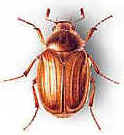
Morphological
characters
The adult chafer is light-brown coloured. It measures 14-18mm
and is covered by soft yellowish hairs. The Summer chafer is slightly more roundish than
the Cock chafer and misses the clear white triangular
dots at its lateral sides.
Distribution
The Summer chafer is less
spread than the Garden chafer. It is recorded from the middle, eastern and southern parts
of the Netherlands. Severe damage appeared on sportsfields around Venlo, Enschede and
Aalten. On some golfcourses in the ninetees the Summer chafer was very abundant and
harmful whereas the Garden chafer played no role of importance in the same locations.
Biology
Not much is known yet about the biology of the Summer chafer.
This species is bivoltine. The flight occurs at sunset. After the flight both sexes
disappear in the dense vegetation of the sward. Mating occurs on the turf after which the
female starts egg-laying in the turf at a suitable place. The eggs hatch after about one
month and the first instars start feeding on grass roots. They develop to a second instar
in which they hibernate. The next year they feed until they reach the third instar and hibernate for a second time to pupate in
May of the following year. Pupation is at about a depth of 30cm and takes a month. At
suitable flight conditions the adults hatch in great masses in the dusk.
The flight
The flight period depends on soil temperatures in spring
during the pupation period. In 1967 mass flights occurred unusually early between 25th of
June and 13th of July after a warm spring. In the summer of 1987 the flight was much
later: from the 20th of July until the first week of August. In 1989, again after a warm
spring the flight started about the 16th of June and ended the second week of July. The
flight of the Summer chafer is quite remarkable. It starts, as with the Cock chafer, in
the evening at sunset and takes one hour, depending on the weather. In contrast with the
Cock chafer they do not fly at dark and do not orientate on lamp light. Females remain low
on the turf where mating takes place. The males fly around the tops of trees, orientating
on dark silhouets against the still light sky. As well as on trees they orientate also on
other objects like humans playing golf.
Copyright © Insect
Consultancy 2002

